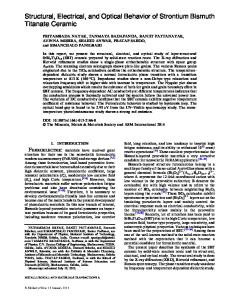Synthesis, Preparation, Structural, Optical, Morphological and Elemental Analysis of Bismuth Oxides Nanoparticles
- PDF / 1,910,755 Bytes
- 7 Pages / 595.276 x 790.866 pts Page_size
- 47 Downloads / 345 Views
ORIGINAL PAPER
Synthesis, Preparation, Structural, Optical, Morphological and Elemental Analysis of Bismuth Oxides Nanoparticles M. Selvapandiyan 1
&
K. Sathiyaraj 1
Received: 1 November 2019 / Accepted: 12 November 2019 # Springer Nature B.V. 2019
Abstract Bismuth oxide nano particles were prepared by Sol Gel method at 100 °C. From the powder XRD pattern, the estimated average crystallite size of as prepared, 300 °C calcinations and 600 °C calcinations are 64.02 nm, 27.47 nm and 17.03 nm respectively. The observed percentage of transmittance is 51% for as prepared, 75% for 300 °C calcinations and 84% for 600 °C calcinations. Fourier transform Infrared studies confirm that Bismuth was bond with oxygen (Bi-O) which confirmed by the peak at 574 cm−1. Atomic % and weight % of Bismuth and Oxygen in Bismuth Oxide were revealed by Energy dispersive X-ray analysis. Surface morphology consists of rod like morphology for as prepared sample and oval shape like morphology with number of breaking pieces for 600 °C calcined sample which was disclosed by scanning electron microscope analysis. The major high intensity PL emission peak was observed at 360 nm in the Ultraviolet region. Keywords Optical materials . Sol-gel technique . Catalysis . Phase transition . Morphology . Luminescence
1 Introduction Bismuth Oxide (Bi2O3) is a well known important transition metal oxide nano crystals which finds wide applications in different fields, such as gas sensors, fuel cells, photo catalysis, antireflecting coating, photo-voltaic cells, optoelectronic devices, memory devices, functional ceramics and high temperature superconducting materials [1–6]. Due to unique properties, such as high photoluminescence, excellent chemical inertness, nontoxic nature, high refractive index and high band gap, Bismuth related compounds increased more attention as photo catalyst that degrade optical pollutant under illumination of UV-Visible light [7–13]. Bismuth oxide nanoparticles have been prepared and analyzed by many researchers. Jha et al. reported on synthesis of bismuth oxide nano particles using bismuth nitrate and urea [14]. Synthesis of bismuth oxide nanopartices at 100 °C was described by patil et al. [15]. Synthesis, characterization and photo catalytic activity of αBi2O3 nanoparticles was given by Hicham Oudghiri-Hassani et al. [16]. Yunhui Yan et al. have synthesized on Template* M. Selvapandiyan [email protected] 1
Department of Physics, Periyar University PG Extension Centre, Dharmapuri, Tamil Nadu 636701, India
free fabrication of α and β-Bi2O3 hollow spheres and their visible light photo catalytic activity for water purification [17]. Tadanon Hashimoto et al. studied the photo catalytic activity of porous Bismuth Oxides polymorphisms [18]. Based on the literature survey and best of our knowledge no authors have been reported the calcinations of the sample at 600 °C. In this present investigation, we have prepared Bismuth Oxide nano particles by Sol-Gel method and calcined at 300 °C and 600 °C. The as prepared and calci
Data Loading...










